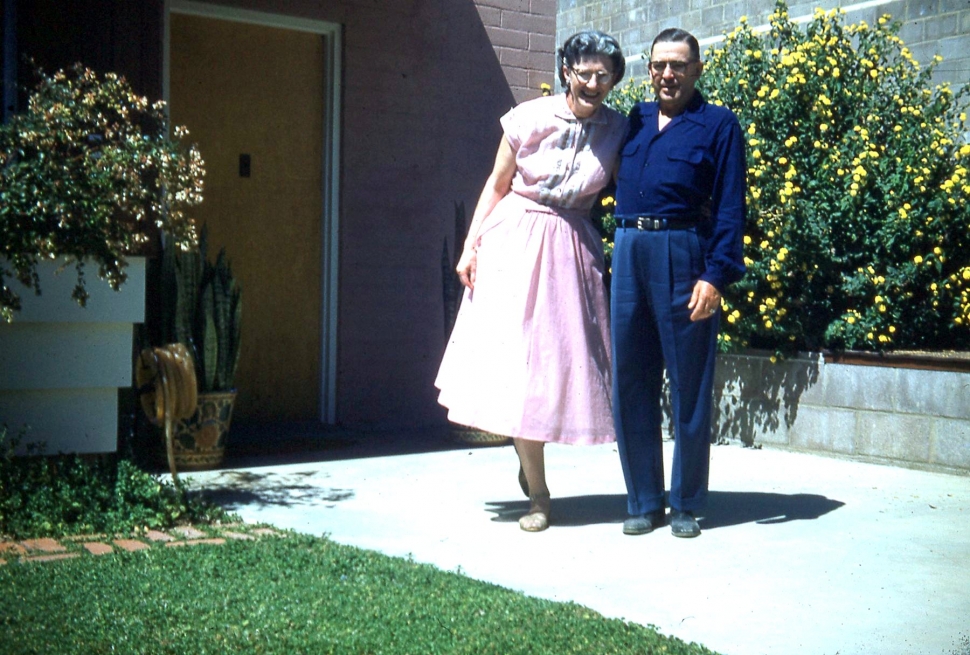|
Who is Edith Moore Jarrett? - Part 2
By Gazette Staff Writers — Thursday, July 25th, 2024
 Above is a photo of Edith with her husband Bert (Bertran “Bert” Roderick), c.1954. They married in 1952. Bert was manager at People’s Lumber and was an active Mason; he passed in 1974. Inset, Hazel Hiberly, on the right, with Edith on the Statendam, c. 1970. Photo credit Fillmore Historical Museum. Edith’s home on Foothill Drive was known for many things; one included a built-in kitchen which was hidden behind a wall, pictured above. Photo credit Fillmore Historical Museum. Pictured above is a mural of a world map done by Lawrence Hinckley, which was one of many unique features in Edith’s home on Foothill Drive. Photo credit Fillmore Historical Museum. Courtesy Fillmore Historical Museum Although the couple seemed to have much in common, in 1940 they divorced. Edith moved into the “Alley Mansion” at 424 Clay. World War II curbed Edith’s travel, but she kept up a steady correspondence with many of her former students. In 1948 she returned to Europe and was disturbed by much that she saw – such as the Dachau Concentration Camp. In March of 1949, Edith started the major project of building a new home on Foothill Drive. She had to have an engineer draw up proper plans for permitting, but essentially, she was the architect of her dream home. While the outside was mid-century modern, it was what was on the inside that “Sunset Magazine” featured. Edith truly believed in built-ins including the kitchen which was hidden behind a wall. One of the more remarkable features was a mural of a world map done by Lawrence Hinckley. It is a pity that later owners chose to paint over the mural which showed the places Edith had visited. In her 1952 holiday letter (always sent in January), her friends learned of the new man in her life. She told of how they met in a store and they both immediately knew theirs would be a special relationship and he moved into the house on Foothill with Edith. He would often want to go out and have fun. If she couldn’t go with him, he would go on his own. Finally, there was a time when he left and didn’t come back. He had left for untamed, non-descended brethren. Yes, Spunky was a skunk. One wonders if Edith ever compared notes with her neighbor on Foothill, Harriet “Petey” Weaver, as to who made a better housemate – a skunk or a racoon. 1952 saw more changes – as in marriage to Bertran “Bert” Roderick, a widower. Although not born in Fillmore, Bert had lived here many years, he was manager at People’s Lumber and was an active Mason. The 1950s and 1960s Edith planned and decorated two duplexes and four homes, including the house on Foothill. She also was busy as a writer and lecturer. She sometimes traveled with Bert but often with friends such as Hazel Hiberly, Fillmore teacher and school principal. Edith loved to fly. She first flew with some barnstormers over Santa Paula in 1918 and flew cross country in 1932, a trip which took two days. As flying became more common, Edith flew whenever she had the chance. So now it is 1972, Marie Wren told the story this way: “My husband, Gene Wren, was on the board for the Chamber of Commerce, and he came home from a meeting one night about 1972 and said, ‘We just put $500 into the pot to start a museum for Fillmore.’” Soon Edith was involved, and the community went through their basements, attics and barns looking for things to donate. The office space the Chamber of Commerce rented in the Masonic Building was turned into a museum. Edith, Dorothy Haase and Ruth Walker oversaw the early growth. Her beloved Bert died in 1974 and her travel schedule again picked up. It was probably a stroke of luck in 1974 that Edith was home in Fillmore and not touring the world. Southern Pacific Railroad announced that they were going to tear down the Fillmore Depot which had sat empty, deteriorating for several years. According to Marie Wren, “Edith made a deal to buy it for $1 and move it across the street so museum items could be moved from the Chamber office into a building of their own and thus, we had a real museum.” The costs to move the depot, which had to be done immediately and to restore it, were paid by Edith as a present to her hometown. Edith was devoted to the Museum, but in 1979 she resigned as curator. The museum was now in the hands of the very capable Dorothy Haase. In 1983 she published “Old Timers’ Tales of Fillmore”, a compilation of articles written for “Vista Magazine.” It has now been reprinted and copies are available at the Museum. Time was catching up with Edith, but it wasn’t diminishing her enthusiasm for life. In 1977 she met for the first time (so she said) another longtime Fillmore resident – Charlie Brown, a well-known outdoorsman who had worked in the oil fields. They were married but unfortunately living together as man and wife did not work out, so Charlie moved out although they remained friends and did not divorce. Edith died on April 11, 1988, after a long illness. She was survived by her sister, Alice Moore Milton, and brother, Fred Moore. Her brother George had passed away in 1986. What has also survived, Edith Moore Jarrett Roderick Brown, is the Fillmore Historical Museum. Even in death Edith was looking out for the Museum, giving an endowment which put the Museum on sound footing. If you haven’t been to the Fillmore Museum, there is no better time than now. |
